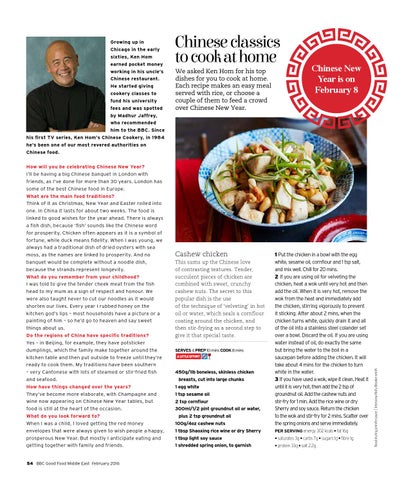How will you be celebrating Chinese New Year? I’ll be having a big Chinese banquet in London with friends, as I’ve done for more than 30 years. London has some of the best Chinese food in Europe. What are the main food traditions? Think of it as Christmas, New Year and Easter rolled into one. In China it lasts for about two weeks. The food is linked to good wishes for the year ahead. There is always a fish dish, because ‘fish’ sounds like the Chinese word for prosperity. Chicken often appears as it is a symbol of fortune, while duck means fidelity. When I was young, we always had a traditional dish of dried oysters with sea moss, as the names are linked to prosperity. And no banquet would be complete without a noodle dish, because the strands represent longevity. What do you remember from your childhood? I was told to give the tender cheek meat from the fish head to my mum as a sign of respect and honour. We were also taught never to cut our noodles as it would shorten our lives. Every year I rubbed honey on the kitchen god’s lips – most households have a picture or a painting of him – so he’d go to heaven and say sweet things about us. Do the regions of China have specific traditions? Yes – in Beijing, for example, they have potsticker dumplings, which the family make together around the kitchen table and then put outside to freeze until they’re ready to cook them. My traditions have been southern – very Cantonese with lots of steamed or stir-fried fish and seafood. How have things changed over the years? They’ve become more elaborate, with Champagne and wine now appearing on Chinese New Year tables, but food is still at the heart of the occasion. What do you look forward to? When I was a child, I loved getting the red money envelopes that were always given to wish people a happy, prosperous New Year. But mostly I anticipate eating and getting together with family and friends.
54 BBC Good Food Middle East February 2016
Chinese classics to cook at home We asked Ken Hom for his top dishes for you to cook at home. Each recipe makes an easy meal served with rice, or choose a couple of them to feed a crowd over Chinese New Year.
Cashew chicken This sums up the Chinese love of contrasting textures. Tender, succulent pieces of chicken are combined with sweet, crunchy cashew nuts. The secret to this popular dish is the use of the technique of ‘velveting’ in hot oil or water, which seals a cornflour coating around the chicken, and then stir-frying as a second step to give it that special taste. SERVES 4 PREP 10 mins COOK 8 mins A LITTLE EFFORT
450g/1lb boneless, skinless chicken breasts, cut into large chunks 1 egg white 1 tsp sesame oil 2 tsp cornflour 300ml/1/2 pint groundnut oil or water, plus 2 tsp groundnut oil 100g/4oz cashew nuts 1 tbsp Shaoxing rice wine or dry Sherry 1 tbsp light soy sauce 1 shredded spring onion, to garnish
Chinese New Year is on February 8
1 Put the chicken in a bowl with the egg white, sesame oil, cornflour and 1 tsp salt, and mix well. Chill for 20 mins. 2 If you are using oil for velveting the chicken, heat a wok until very hot and then add the oil. When it is very hot, remove the wok from the heat and immediately add the chicken, stirring vigorously to prevent it sticking. After about 2 mins, when the chicken turns white, quickly drain it and all of the oil into a stainless steel colander set over a bowl. Discard the oil. If you are using water instead of oil, do exactly the same but bring the water to the boil in a saucepan before adding the chicken. It will take about 4 mins for the chicken to turn white in the water. 3 If you have used a wok, wipe it clean. Heat it until it is very hot, then add the 2 tsp of groundnut oil. Add the cashew nuts and stir-fry for 1 min. Add the rice wine or dry Sherry and soy sauce. Return the chicken to the wok and stir-fry for 2 mins. Scatter over the spring onions and serve immediately. PER SERVING energy 302 kcals • fat 16g
• saturates 3g • carbs 7g • sugars 1g • fibre 1g • protein 33g • salt 2.2g
Food styling jennifer joyce | Interview Holly Brooke-smith
Growing up in Chicago in the early sixties, Ken Hom earned pocket money working in his uncle’s Chinese restaurant. He started giving cookery classes to fund his university fees and was spotted by Madhur Jaffrey, who recommended him to the BBC. Since his first TV series, Ken Hom’s Chinese Cookery, in 1984 he’s been one of our most revered authorities on Chinese food.
